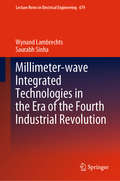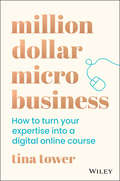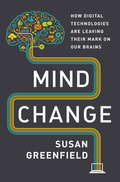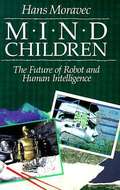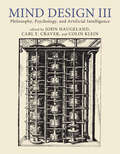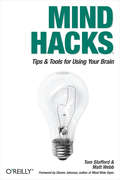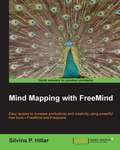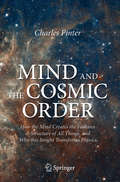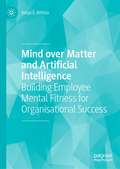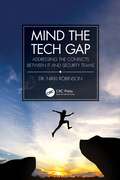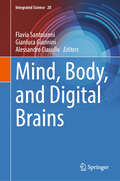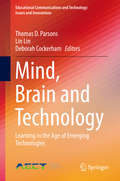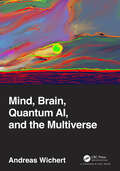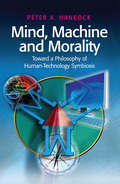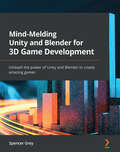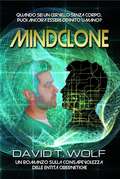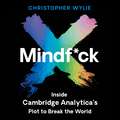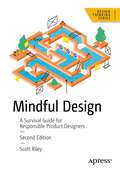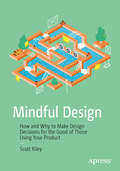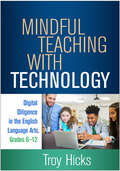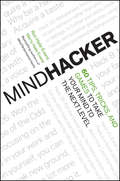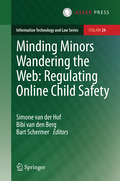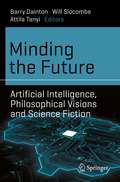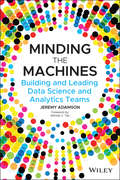- Table View
- List View
Millimeter-wave Integrated Technologies in the Era of the Fourth Industrial Revolution (Lecture Notes in Electrical Engineering #679)
by Saurabh Sinha Wynand LambrechtsThis peer-reviewed book explores the technologies driving broadband internet connectivity in the fourth industrial revolution (Industry 4.0). It particularly focuses on potential solutions to introduce these technologies in emerging markets and rural areas, regions that typically form part of the digital divide and often have under-developed telecommunications infrastructures, a lack of skilled workers, and geographical restrictions that limit broadband connectivity. Research shows that ubiquitous internet access boosts socio-economic growth through innovations in science and technology, with the common goal of bringing positive change to the lives of individuals. Fifth-generation (5G) networks based on millimeter-wave (mm-wave) frequency information transfer have the potential to provide future-proof, affordable and sustainable broadband connectivity in areas where previous-generation mobile networks were unable to do so. This book discusses the principles of various technologies that enable electronic circuits to operate at mm-wave frequencies. It examines the importance of identifying, describing, and analyzing technology from a purely technological standpoint, but also acknowledges and investigates the challenges and limitations of introducing such technologies in emerging markets. Presenting recent research, the book spearheads participation in Industry 4.0 in these areas.
Million Dollar Micro Business: How to Turn Your Expertise Into a Digital Online Course
by Tina TowerDiscover how to launch a profitable online course from scratch In Million Dollar Micro Business: How To Turn Your Expertise Into A Digital Online Course, entrepreneur and author Tina Tower delivers a new and smarter way to do business that avoids huge overheads and large capital investments. Fueled by recent innovations in technology and shifts in consumer behavior, the accomplished author shows you a new way to have a big impact with few resources. You’ll learn how to create a digital course based on expertise you’ve gained through your life, business, academic work, and career. The book is a practical and tangible guide to getting started and offers a proven framework and case studies of people who have scaled courses into seven-figure ventures. This important book teaches you: How to turn your passion and expertise into profit, using what you know to create a global, online course Why bigger is not always better, and how less overhead and investment is often a good thing for a scalable business An alternative to the 9-5 hustle and grind of a traditional workplace Real-life case studies from people who have been on this journey before Perfect for entrepreneurs, seasoned professionals, educated experts, and anyone else interested in sharing their knowledge with the world around them, Million Dollar Micro Business is an indispensable guide to creating a lucrative online course from scratch.
Mind Change
by Susan GreenfieldWe live in a world unimaginable only decades ago: a domain of backlit screens, instant information, and vibrant experiences that can outcompete dreary reality. Our brave new technologies offer incredible opportunities for work and play. But at what price? Now renowned neuroscientist Susan Greenfield--known in the United Kingdom for challenging entrenched conventional views--brings together a range of scientific studies, news events, and cultural criticism to create an incisive snapshot of "the global now." Disputing the assumption that our technologies are harmless tools, Greenfield explores whether incessant exposure to social media sites, search engines, and videogames is capable of rewiring our brains, and whether the minds of people born before and after the advent of the Internet differ. Stressing the impact on Digital Natives--those who've never known a world without the Internet--Greenfield exposes how neuronal networking may be affected by unprecedented bombardments of audiovisual stimuli, how gaming can shape a chemical landscape in the brain similar to that in gambling addicts, how surfing the Net risks placing a premium on information rather than on deep knowledge and understanding, and how excessive use of social networking sites limits the maturation of empathy and identity. But Mind Change also delves into the potential benefits of our digital lifestyle. Sifting through the cocktail of not only threat but opportunity these technologies afford, Greenfield explores how gaming enhances vision and motor control, how touch tablets aid students with developmental disabilities, and how political "clicktivism" foments positive change. In a world where adults spend ten hours a day online, and where tablets are the common means by which children learn and play, Mind Change reveals as never before the complex physiological, social, and cultural ramifications of living in the digital age. A book that will be to the Internet what An Inconvenient Truth was to global warming, Mind Change is provocative, alarming, and a call to action to ensure a future in which technology fosters--not frustrates--deep thinking, creativity, and true fulfillment.Praise for Mind Change "This is just the book we need now as we proceed to absorb fresh digital innovations: a scientific review of their effects on the brain and what they mean for our minds. Mind Change clearly presents to lay readers the latest experimental findings as Susan Greenfield brings to the digital revolution just the right level of skepticism and curiosity. Neither a naysayer nor an enthusiast, she is a sober, reliable, and engaging voice on screen experience, telling us what happens inside our heads each time we log on, connect, play, and emote."--Mark Bauerlein, author of The Dumbest Generation: How the Digital Age Stupefies Young Americans and Jeopardizes Our Future (Or, Don't Trust Anyone Under 30) "Greenfield's Mind Change . . . proposes that global climate change can serve as a useful metaphor for how human minds--our inner environments--are, in her view, being recklessly altered by digital technologies. . . . Mind Change is an important presentation of an uncomfortable minority position."--Jaron Lanier, Nature "Greenfield is a lucid and thorough communicator, and this book is highly accessible to those with no knowledge of neuroscience. . . . That I kept being distracted from my reading to check Facebook was less a reflection on the quality of the book than a sobering lesson in how relevant these issues are."--The Independent (U.K.)From the Hardcover edition.
Mind Children: The Future of Robot and Human Intelligence
by Hans MoravecArguing that within the next fifty years machines will equal humans not only in reasoning power but also in their ability to perceive, interact with, and change their environment, the author describes the tremendous technological advances possible in thefield of robotics.
Mind Design III: Philosophy, Psychology, and Artificial Intelligence
by John Haugeland, Carl F. Craver, and Colin KleinThe essential reader on the philosophical foundations and implications of artificial intelligence, now comprehensively updated for the twenty-first century.In the quarter century since the publication of John Haugeland&’s Mind Design II, computer scientists have hit many of their objectives for successful artificial intelligence. Computers beat chess grandmasters, driverless cars navigate streets, autonomous robots vacuum our homes, and ChatGPT answers existential queries in iambic pentameter on command. Engineering has made incredible strides. But have we made progress in understanding and building minds? Comprehensively updated by Carl Craver and Colin Klein to reflect the astonishing ubiquity of machine learning in modern life, Mind Design III offers an essential collection of classic and contemporary essays on the philosophical foundations and implications of artificial intelligence. Contributions from a diverse range of philosophers and computer scientists address the nature of computation, the nature of thought, and the question of whether computers can be made to think. With extensive new material reflecting the explosive growth and diversification of AI approaches, this classic reader equips students to assess the possibility of, and progress toward, building minds out of computers.New edition highlights: New chapters on advances in deep neural networks, reinforcement learning, and causal learningNew material on the complementary intersection of neuroscience and AIOrganized thematically rather than chronologically Brand new introductions to each section that include suggestions for coursework and further reading
Mind Hacks: Tips & Tricks for Using Your Brain
by Tom Stafford Matt WebbThe brain is a fearsomely complex information-processing environment--one that often eludes our ability to understand it. At any given time, the brain is collecting, filtering, and analyzing information and, in response, performing countless intricate processes, some of which are automatic, some voluntary, some conscious, and some unconscious.Cognitive neuroscience is one of the ways we have to understand the workings of our minds. It's the study of the brain biology behind our mental functions: a collection of methods--like brain scanning and computational modeling--combined with a way of looking at psychological phenomena and discovering where, why, and how the brain makes them happen.Want to know more? Mind Hacks is a collection of probes into the moment-by-moment works of the brain. Using cognitive neuroscience, these experiments, tricks, and tips related to vision, motor skills, attention, cognition, subliminal perception, and more throw light on how the human brain works. Each hack examines specific operations of the brain. By seeing how the brain responds, we pick up clues about the architecture and design of the brain, learning a little bit more about how the brain is put together.Mind Hacks begins your exploration of the mind with a look inside the brain itself, using hacks such as "Transcranial Magnetic Stimulation: Turn On and Off Bits of the Brain" and "Tour the Cortex and the Four Lobes." Also among the 100 hacks in this book, you'll find:Release Eye Fixations for Faster ReactionsSee Movement When All is StillFeel the Presence and Loss of AttentionDetect Sounds on the Margins of CertaintyMold Your Body SchemaTest Your HandednessSee a Person in Moving LightsMake Events Understandable as Cause-and-EffectBoost Memory by Using ContextUnderstand Detail and the Limits of AttentionSteven Johnson, author of "Mind Wide Open" writes in his foreword to the book, "These hacks amaze because they reveal the brain's hidden logic; they shed light on the cheats and shortcuts and latent assumptions our brains make about the world." If you want to know more about what's going on in your head, then Mind Hacks is the key--let yourself play with the interface between you and the world.
Mind Mapping with FreeMind
by Silvina P. HillarThe book is presented in easy to follow Cookbook recipes covering a wide variety of tasks and applications. The book is for users of FreeMind and FreePlane or new users who would like to explore the world of free mind mapping software. No previous experience is required.
Mind and the Cosmic Order: How the Mind Creates the Features & Structure of All Things, and Why this Insight Transforms Physics
by Charles PinterThe topic of this book is the relationship between mind and the physical world. From once being an esoteric question of philosophy, this subject has become a central topic in the foundations of quantum physics. The book traces this story back to Descartes, through Kant, to the beginnings of 20th Century physics, where it becomes clear that the mind-world relationship is not a speculative question but has a direct impact on the understanding of physical phenomena. The book’s argument begins with the British empiricists who raised our awareness of the fact that we have no direct contact with physical reality, but it is the mind that constructs the form and features of objects. It is shown that modern cognitive science brings this insight a step further by suggesting that shape and structure are not internal to objects, but arise in the observer. The author goes yet further by arguing that the meaningful connectedness between things — the hierarchical organization of all we perceive — is the result of the Gestalt nature of perception and thought, and exists only as a property of mind. These insights give the first glimmerings of a new way of seeing the cosmos: not as a mineral wasteland but a place inhabited by creatures.
Mind at Play: The Psychology of Video Games
by Geoffrey. R. Loftus Elizabeth F. LoftusExamines the psychological processes involved in playing video games, discusses behavior problems frequent players can develop, and compares video games to other fads of the past.
Mind over Matter and Artificial Intelligence: Building Employee Mental Fitness for Organisational Success
by Vidya S. AthotaThis book explores mind over matter in a digital age and presents the importance of continued transformation of the mind to promote humane Artificial Intelligence for greater good. In doing so, it focuses on the organizational and managerial practices that are critical in creating an environment that supports mindset and organizational growth. The digital age is significantly impacting employees and organizations and steering billions of people around the world. Artificial Intelligence has created a whole new paradigm with a revolution loftier than all the industrial revolutions and the innovations of the past millennia combined. We are either headed towards restoring humanity back to the “Imago Dei”, where creative powers are unleashed in human freedom, or advocating selective breeding and “survival of the fittest”.
Mind the Tech Gap: Addressing the Conflicts between IT and Security Teams
by Nikki RobinsonIT and cybersecurity teams have had a long-standing battle between functionality and security. But why? To understand where the problem lies, this book will explore the different job functions, goals, relationships, and other factors that may impact how IT and cybersecurity teams interact. With different levels of budget, competing goals, and a history of lack of communication, there is a lot of work to do to bring these teams together. Empathy and emotional intelligence are common phenomena discussed in leadership books, so why not at the practitioner level? Technical teams are constantly juggling projects, engineering tasks, risk management activities, security configurations, remediating audit findings, and the list goes on. Understanding how psychology and human factors engineering practices can improve both IT and cybersecurity teams can positively impact those relationships, as well as strengthen both functionality and security. There is no reason to have these teams at odds or competing for their own team’s mission; align the missions, and align the teams. The goal is to identify the problems in your own team or organization and apply the principles within to improve how teams communicate, collaborate, and compromise. Each organization will have its own unique challenges but following the question guide will help to identify other technical gaps horizontally or vertically.
Mind, Body, and Digital Brains (Integrated Science #20)
by Flavia Santoianni Alessandro Ciasullo Gianluca GianniniThis book—Mind, Body, and Digital Brains—focuses on both theoretical and empirical issues and joins contributions from different disciplines, concepts, and sensibilities, bringing together scholars from fields that at first glance may appear different—Neuroscience and Cognitive Neuroscience; Robotics, Computer Science, Deep Learning, and Information Processing Systems; Education, Philosophy, Law, and Psychology. All these research fields are held together by the very object to be discussed: a broad, articulate, and polyphonic reflection on the status of theories and fields of application of Digital Technologies and Artificial Intelligence, seen from the perspective of the digital mind, digital body, and digital brain. Scientific and humanistic issues will be considered through an interdisciplinary point of view, with the purpose of deepening emerging trends about various disciplines. This book offers a framework for different perspectives and, at the same time, a platform for discussion aimed not only at experts, but also at a non-specialist public interested in the digital revolution. The digital revolution is emerging from the intertwining of ethical, philosophical, and technological aspects, which concern several general issues as cooperation, law, and environment, but also specialized as cybersecurity or algorithmic citizenship. More questions arise, concerning which opportunities and risks are associated with the new scenarios, what idea of humanity is emerging from the increasingly widespread use of Artificial Intelligence technologies, and what idea of integrated science should we promote to accompany the ongoing transformations.
Mind, Brain and Technology: Learning in the Age of Emerging Technologies (Educational Communications and Technology: Issues and Innovations)
by Thomas D. Parsons Lin Lin Deborah CockerhamAs technology becomes increasingly integrated into our society, cultural expectations and needs are changing. Social understanding, family roles, organizational skills, and daily activities are all adapting to the demands of ever-present technology, causing changes in human brain, emotions, and behaviors. An understanding of the impact of technology upon our lives is essential if we are to adequately educate children for the future and plan for meaningful learning environments for them. Mind, Brain and Technology provides an overview of these changes from a wide variety of perspectives. Designed as a textbook for students in the fields and interdisciplinary areas of psychology, neuroscience, technology, computer science, and education, the book offers insights for researchers, professionals, educators, and anyone interested in learning more about the integration of mind, brain and technology in their lives. The book skilfully guides readers to explore alternatives, generate new ideas, and develop constructive plans both for their own lives and for future educational needs.
Mind, Brain, Quantum AI, and the Multiverse
by Andreas WichertMind, Brain, Quantum AI, and the Multiverse There is a long-lasting controversy concerning our mind and consciousness.This book proposes a connection between the mind, the brain, and the multiverse. The author introduces the main philosophical ideas concerning mind and freedom, and explains the basic principles of computer science, artificial intelligence of brain research, quantum physics, and quantum artificial intelligence. He indicates how we can provide an answer to the problem of the mind and consciousness by describing the nature of the physical world. His proposed explanation includes the Everett Many-Worlds theory. Mind, Brain, Quantum AI, and the Multiverse tries to avoid any non-essential metaphysical speculations. The book is an essential compilation of knowledge in philosophy, computer science, biology, and quantum physics. It is written for readers without any requirements in mathematics, physics, or computer science.
Mind, Machine and Morality: Toward a Philosophy of Human-Technology Symbiosis
by Peter A. HancockTechnology is our conduit of power. In our modern world, technology is the gatekeeper deciding who shall have and who shall have not. Either technology works for you or you work for technology. It shapes the human race just as much as we shape it. But where is this symbiosis going? Who provides the directions, the intentions, the goals of this human-machine partnership? Such decisions do not derive from the creators of technology who are enmeshed in their individual innovations. They neither come from our social leaders who possess only sufficient technical understanding to react to innovations, not to anticipate or direct their progress. Neither is there evidence of some omnipotent 'invisible hand,' the simple fact is that no one is directing this enterprise. In Mind, Machine and Morality, Peter Hancock asks questions about this insensate progress and has the temerity to suggest some cognate answers. He argues for the unbreakable symbiosis of purpose and process, and examines the dangerous possibilities that emerge when science and purpose meet. Historically, this work is a modern-day child of Bacon's hope for the 'Great Instauration.' However, unlike its forebear, the focus here is on human-machine systems. The emphasis centers on the conception that the active, extensive face of modern philosophy is technology. Whatever we are to become is bound up not only in our biology but critically in our technology also. And to achieve rational progress we need to articulate manifest purpose. This book is one step along the purposive road. Drawing together his many seminal writings on human-machine interaction and adapting these works specifically for this collection, Peter Hancock provides real food for thought, delighting readers with his unique philosophical perspective and outstanding insights. This is theoretical work of the highest order and will open minds accordingly.
Mind-Melding Unity and Blender for 3D Game Development: Unleash the power of Unity and Blender to create amazing games
by Spencer GreyAdd Blender to your Unity game development projects to unlock new possibilities and decrease your dependency on third-party creatorsKey FeaturesDiscover how you can enhance your games with BlenderLearn how to implement Blender in real-world scenariosCreate new or modify existing assets in Blender and import them into your Unity gameBook DescriptionBlender is an incredibly powerful, free computer graphics program that provides a world-class, open-source graphics toolset for creating amazing assets in 3D. With Mind-Melding Unity and Blender for 3D Game Development, you'll discover how adding Blender to Unity can help you unlock unlimited new possibilities and reduce your reliance on third parties for creating your game assets. This game development book will broaden your knowledge of Unity and help you to get to grips with Blender's core capabilities for enhancing your games. You'll become familiar with creating new assets and modifying existing assets in Blender as the book shows you how to use the Asset Store and Package Manager to download assets in Unity and then export them to Blender for modification. You'll also learn how to modify existing and create new sci-fi-themed assets for a minigame project. As you advance, the book will guide you through creating 3D model props, scenery, and characters and demonstrate UV mapping and texturing. Additionally, you'll get hands-on with rigging, animation, and C# scripting. By the end of this Unity book, you'll have developed a simple yet exciting mini game with audio and visual effects, and a GUI. More importantly, you'll be ready to apply everything you've learned to your Unity game projects.What you will learnTransform your imagination into 3D scenery, props, and characters using BlenderGet to grips with UV unwrapping and texture models in BlenderUnderstand how to rig and animate models in BlenderAnimate and script models in Unity for top-down, FPS, and other types of gamesFind out how you can roundtrip custom assets from Blender to Unity and backBecome familiar with the basics of ProBuilder, Timeline, and Cinemachine in UnityWho this book is forThis book is for game developers looking to add more skills to their arsenal by learning Blender from the ground up. Beginner-level Unity scene and scripting skills are necessary to get started.
Mindclone - Quando sei un cervello senza corpo, puoi ancora essere definito umano?: UN ROMANZO SULLA CONSAPEVOLEZZA DELLE ENTITÀ CIBERNETICHE
by Vittorio Rossi David T. WolfMarc Gregorio si risveglia paralizzato. Non riesce più a percepire il proprio corpo. Incidente? Infarto? Qualcuno gli ha fatto un'overdose di Botox? La risposta, scoprirà poi, è molto, molto peggiore. Lui è soltanto una copia di Marc, è un cervello digitale senza un corpo, dotato di tutti i ricordi umani di Marc, ma senza alcun accesso ai piaceri sensuali degli esseri umani. Ora deve trovare un motivo per continuare a "vivere". Adam il Mindclone incontra il vero Marc Gregorio... e la sua nuova ragazza, Molly Schaeffer. Anche Adam è innamorato di lei. Ma come può un'entità digitale sperimentare l'amore? Non può nemmeno gustare una pizza. L'unica sua consolazione: il suo potente cervello digitale. Spinto da Molly, si dedica così a scoprire trame terroristiche, attentati alle scuole, abusi dei membri del Congresso e imbrogli a Wall Street. Le sue buone azioni sollevano però l'interesse di un fornitore militare, assetato di potere, che non si fermerà davanti a nulla — furti, rapimenti e anche peggio — per ottenere il controllo della tecnologia. Senza un corpo, come potrà Adam salvare sè stesso – ed il mondo intero – da un terribile destino?
Mindf*ck: Inside Cambridge Analytica's Plot to Break the World
by AnonymousWhat if you could peer into the minds of an entire population? What if you could target the weakest with rumours that only they saw?In 2016, an obscure British military contractor turned the world upside down. Funded by a billionaire on a crusade to start his own far-right insurgency, Cambridge Analytica combined psychological research with private Facebook data to make an invisible weapon with the power to change what voters perceived as real.The firm was created to launch the then unknown Steve Bannon's ideological assault on America. But as it honed its dark arts in elections from Trinidad to Nigeria, 24-year-old research director Christopher Wylie began to see what he and his colleagues were unleashing.He had heard the disturbing visions of the investors. He saw what CEO Alexander Nix did behind closed doors. When Britain shocked the world by voting to leave the EU, Wylie realised it was time to expose his old associates. The political crime of the century had just taken place - the weapon had been tested - and nobody knew.
Mindful Design: A Survival Guide for Responsible Product Designers (Design Thinking)
by Scott RileyLearn to create seamless designs backed by a responsible understanding of the human mind. This new edition is fully updated and reworked to employ a realistic, challenging, and practical approach to interface design, presenting state of the art scientific studies in behavioral sciences, interface design and the psychology of design. All with modern, up-to-date examples and screenshots. The practical portion of this edition has been completely reworked, giving you the chance to follow along with a real, proven design process that has produced several successful products imbued with the principles of mindful, responsible design.You'll examine how human behavior can be used to integrate your product design into lifestyle, rather than interrupt it, and make decisions for the good of those that are using your product. You will also learn about the neurological aspects and limitations of human vision and perception; about our attachment to harmony and dissonance; and about our brain’s propensity towards pattern recognition and how we perceive the world around us. In the second half of the book, you’ll follow along with the key phases of a design project, implementing what you have learned in an end-to-end, practical setting. Design is a responsibility, but not enough designers understand the human mind or the process of thought. Mindful Design, Second Edition introduces the areas of brain science that matter to designers, and passionately explains how those areas affect each human’s day-to-day experiences with products and interfaces, providing a battle-tested toolkit to help you make responsible design decisions. What You'll Learn Review how attention and distraction work and the cost of attentional switchingUse Gestalt principles to communicate visual groupingEnsure your underlying models make sense to your audienceUse time, progression, and transition to create a compositionCarefully examine controlling behavior through reductionist and behaviorist motivation concepts Apply the theoretical knowledge to practical, mindful interface design Who This Book Is For The primary audience for this book is professional designers who wish to learn more about the human mind and how to apply that to their work. The book is also useful for design-focused product owners and startup founders who wish to apply ethical thinking to a team, or when bootstrapping their products. The secondary audience is design students who are either studying a ‘traditional’ visual design course, or a UX/interaction design course who have a desire to learn how they might be able to apply mindful design to their early careers. Finally, a tertiary audience for this book would be tutors involved in teaching design, or peripheral, courses who may wish to incorporate its teachings into their lectures, workshops or seminars.
Mindful Design: How And Why To Make Design Decisions For The Good Of Those Using Your Product
by Scott RileyLearn to create seamless designs backed by a responsible understanding of the human mind. This book examines how human behavior can be used to integrate your product design into lifestyle, rather than interrupt it, and make decisions for the good of those that are using your product. Mindful Design introduces the areas of brain science that matter to designers, and passionately explains how those areas affect each human’s day-to-day experiences with products and interfaces. You will learn about the neurological aspects and limitations of human vision and perception; about our attachment to harmony and dissonance, such as visual harmony, musical harmony; and about our brain’s propensity towards pattern recognition and how we perceive the world cognitively. In the second half of the book you will focus on the practical application of what you have learned, specific to interaction and interface design. Real-world examples are used throughout so that you can really see how design is impacting our everyday digital experience. Design is a responsibility, but not enough designers understand the human mind or the process of thought. This book explores the key factors involved and shows you how to make the right design choices. What You'll Learn Review how attention and distraction work and the cost of attentional switchingUse Gestalt principles to communicate visual groupingEnsure your underlying models make sense to your audienceUse time, progression, and transition to create a compositionCarefully examine controlling behavior through reductionist and behaviorist motivation concepts Apply the theoretical knowledge to practical, mindful application design Who This Book Is For The primary audience for this book is professional designers who wish to learn more about the human mind and how to apply that to their work. The book is also useful for design-focussed product owners and startup founders who wish to apply ethical thinking to a team, or when bootstrapping their products. The secondary audience is design students who are either studying a ‘traditional’ visual design course, or a UX/interaction design course who have a desire to learn how they might be able to apply mindful design to their early careers. Finally, a tertiary audience for this book would be tutors involved in teaching design, or peripheral, courses who may wish to incorporate its teachings into their lectures, workshops or seminars.
Mindful Teaching with Technology: Digital Diligence in the English Language Arts, Grades 6-12
by Troy HicksTechnology is integral to teaching in the English language arts, whether in-person, hybrid, or remote. In this indispensable guide, Troy Hicks shows how to teach and model "digital diligence"--an alert, intentional stance that helps both teachers and students use technology productively, ethically, and responsibly. Resources and lesson ideas are presented to build adolescents' skills for protecting online privacy, minimizing digital distraction, breaking through &“filter bubbles,&” fostering civil conversations, evaluating information on the Internet, creating meaningful digital writing, and deeply engaging with multimedia texts. Dozens of websites, apps, and other tools are reviewed, with links provided at the companion website; end-of-chapter teaching points and guiding questions facilitate learning and application.
Mindhacker
by Ron Hale-Evans Marty Hale-EvansCompelling tips and tricks to improve your mental skills Don't you wish you were just a little smarter? Ron and Marty Hale-Evans can help with a vast array of witty, practical techniques that tune your brain to peak performance. Founded in current research, Mindhacker features 60 tips, tricks, and games to develop your mental potential. This accessible compilation helps improve memory, accelerate learning, manage time, spark creativity, hone math and logic skills, communicate better, think more clearly, and keep your mind strong and flexible.
Minding Minors Wandering the Web: Regulating Online Child Safety
by Simone van der Hof Bibi van den Berg Bart SchermerEnsuring online safety has become a topic on the regulatory agenda in many Western societies. However, regulating for online safety is far from easy, due to the wide variety of national and international, private and public actors and stakeholders that are involved. When regulating online risks for children it is important to strike the right balance between protection against harms on the one hand and safeguarding their fundamental freedoms and rights on the other. The authors in this book attempt to grapple with precisely this theme: striking the right balance between ensuring safety for children on the internet while at the same time enabling them to experiment, to learn, to enrich their lives, to acquire skills and to have fun using this global network. The authors come from various scientific disciplines, ranging from law to social science and from media studies to philosophy. This means that the book provides the reader with both empirical and theoretical/conceptual chapters and sheds a multi-disciplinary light on the complex topic of regulating online safety for children.
Minding the Future: Artificial Intelligence, Philosophical Visions and Science Fiction (Science and Fiction)
by Barry Dainton Will Slocombe Attila TanyiBringing together literary scholars, computer scientists, ethicists, philosophers of mind, and scholars from affiliated disciplines, this collection of essays offers important and timely insights into the pasts, presents, and, above all, possible futures of Artificial Intelligence. This book covers topics such as ethics and morality, identity and selfhood, and broader issues about AI, addressing questions about the individual, social, and existential impacts of such technologies. Through the works of science fiction authors such as Isaac Asimov, Stanislaw Lem, Ann Leckie, Iain M. Banks, and Martha Wells, alongside key visual productions such as Ex Machina, Westworld, and Her, contributions illustrate how science fiction might inform potential futures as well as acting as a springboard to bring disciplinary knowledge to bear on significant developments of Artificial Intelligence. Addressing a broad, interdisciplinary audience, both expert and non-expert readers gain an in-depth understanding of the wide range of pressing issues to which Artificial Intelligence gives rise, and the ways in which science fiction narratives have been used to represent them. Using science fiction in this manner enables readers to see how even fictional worlds and imagined futures have very real impacts on how we understand these technologies. As such, readers are introduced to theoretical positions on Artificial Intelligence through fictional works as well as encouraged to reflect on the diverse aspects of Artificial Intelligence through its many philosophical, social, legal, scientific, and cultural ramifications.
Minding the Machines: Building and Leading Data Science and Analytics Teams
by Jeremy AdamsonOrganize, plan, and build an exceptional data analytics team within your organization In Minding the Machines: Building and Leading Data Science and Analytics Teams, AI and analytics strategy expert Jeremy Adamson delivers an accessible and insightful roadmap to structuring and leading a successful analytics team. The book explores the tasks, strategies, methods, and frameworks necessary for an organization beginning their first foray into the analytics space or one that is rebooting its team for the umpteenth time in search of success. In this book, you’ll discover: A focus on the three pillars of strategy, process, and people and their role in the iterative and ongoing effort of building an analytics team Repeated emphasis on three guiding principles followed by successful analytics teams: start early, go slow, and fully commit The importance of creating clear goals and objectives when creating a new analytics unit in an organization Perfect for executives, managers, team leads, and other business leaders tasked with structuring and leading a successful analytics team, Minding the Machines is also an indispensable resource for data scientists and analysts who seek to better understand how their individual efforts fit into their team’s overall results.
